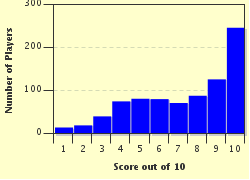Quiz Answer Key and Fun Facts
1. San Marino takes its name from its founder, Marinus of Rab. The stonecutter founded the republic in 301 A.D after fleeing his home island to take up work in rebuilding the city walls of Rimini in Italy. Shortly after his arrival, Marinus was sent to the area which now bears his name to gather the stone needed for the walls. From which modern day country did Marinus, also known as Marinus the Dalmatian, originally hail?
2. San Marino has an enviable record of peace and harmony throughout most of its existence. This harmonious history is reflected in the full official title of the republic. What is the full name?
3. In 1463, the towns of Fiorentino, Montegiardino and Serravalle were gifted to San Marino by Pope Pius II, in recognition of the republic's support for the Papacy in its battles against the Duke of Rimini. These towns represented the first new territories added to San Marino since its founding more than a millennium earlier. Prior to these gifts, the territory consisted solely of the land around which mountain?
4. As Italy moved towards unification in the 19th century, San Marino acted as a place of sanctuary for those evading the grip of the occupying Austrians. As reward for providing this refuge, the architect of Italian unification allowed San Marino to remain geographically within, but politically outside, of the new nation. Who was this man who ensured San Marino's continuing independence?
5. San Marino demonstrates that "government founded on republican principles is capable of being so administered as to be secure and enduring." So said the now-revered president of his own troubled republic on being made an honorary Sammarinese. Who was the politician whom, in 1861, was made San Marino's first honorary citizen in recognition of his fight against slavery?
6. San Marino declared itself neutral at the outbreak of World War I. However, in the course of the war Austria broke off diplomatic relations with the republic. Why?
7. Despite its government's close association with Fascist Italy, San Marino played little part in the battles of World War II. This changed in 1944 as Germany began a fighting retreat from Italy. In September of that year came the Battle of San Marino, part of Operation Olive, the allied attempt to break the German defensive line. In an attempt to obscure the value of this front, Hitler had changed its name to the Green Line. By what name had it been known prior to this?
8. After the years of Fascist rule, San Marino finally had a general election at the end of World War II. What political first could San Marino lay claim to as a result of the election of 1945?
9. Though San Marino is not rich in natural resources, there is one commodity from the country that is much sought after around the world. After tourism, it represents the second largest contributor to its GDP. What does San Marino produce that is so popular?
10. Being a small country, San Marino has an unsurprisingly unremarkable sporting history. However, in the course of a football match with England in 1993, San Marino became world record holders. What, given the opposition, was the remarkable and unexpected record that they set?
Source: Author
Snowman
This quiz was reviewed by FunTrivia editor
bloomsby before going online.
Any errors found in FunTrivia content are routinely corrected through our feedback system.

